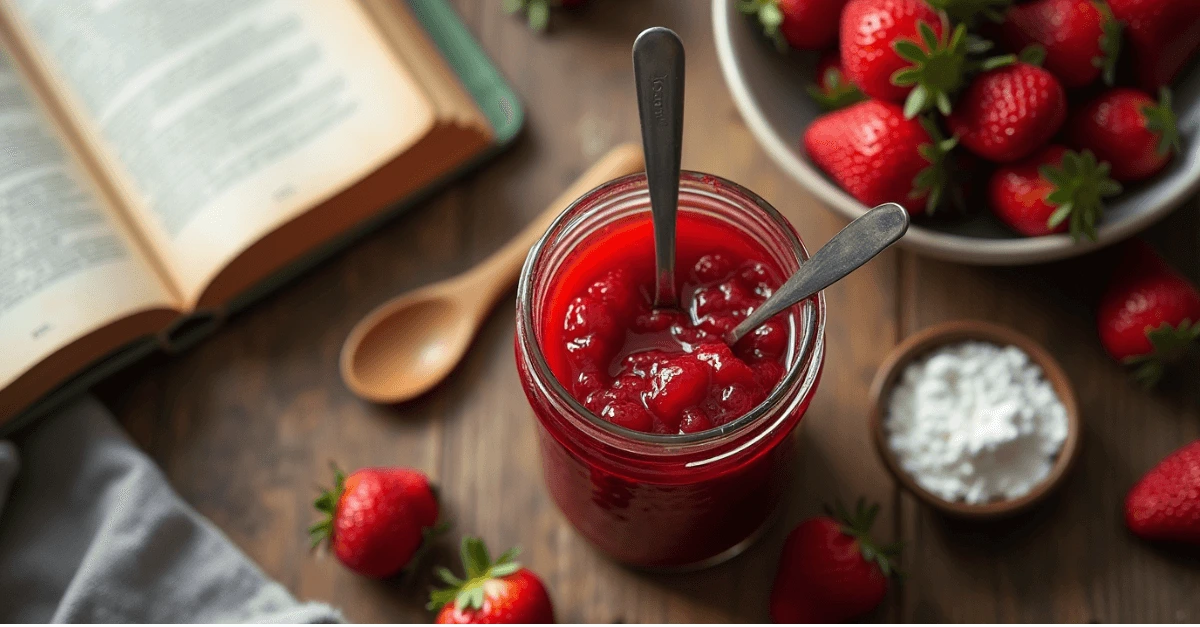There’s something incredibly rewarding about making your own strawberry preserves—the deep red hue, the delightful aroma filling your kitchen, and the satisfaction of enjoying a homemade spread. Store-bought options often contain additives, but when you craft it yourself, you get a fresher, more flavorful result. If the idea of making preserves feels overwhelming, don’t worry—this guide breaks it down step by step.
By following this simple process, you’ll learn how to make strawberry preserves with pectin that are packed with flavor and have the perfect consistency. Let’s get started!
Why Add Pectin to Strawberry Preserves?
Pectin is a natural thickening agent found in fruit, and it plays an essential role in achieving the ideal texture. Here’s why incorporating pectin can elevate your homemade preserves:
- Reduces cooking time – Speeds up the thickening process, preventing the need for prolonged simmering.
- Retains fresh fruit flavor – A shorter cooking duration helps maintain the strawberries’ natural sweetness.
- Achieves the perfect consistency – Ensures your preserves are neither too runny nor overly stiff.
- Allows for less sugar – Helps maintain the right texture even with a reduced sugar content.
Ingredients & Equipment You’ll Need
Ingredient List
| Ingredient | Quantity |
|---|---|
| Fresh Strawberries | 4 cups (chopped) |
| Sugar | 3 cups |
| Liquid Pectin | 1 pouch (or powdered version) |
| Lemon Juice | 2 tbsp |
| Water | ½ cup |

Essential Kitchen Tools
- Large cooking pot
- Wooden spoon
- Sterilized canning jars and lids
- Potato masher
- Ladle
Step-by-Step Instructions for Making Strawberry Preserves
1. Preparing the Strawberries
- Rinse your strawberries under cool running water.
- Remove the stems and hull them to get rid of any unwanted parts.
- Either chop them finely or mash them, depending on whether you prefer a chunky or smooth consistency.
2. Cooking the Preserves
- In a large pot, combine the strawberries, sugar, and lemon juice.
- Stir the mixture over medium heat until the sugar fully dissolves.
- Bring the mixture to a steady boil while stirring frequently.
3. Incorporating the Pectin
- Once boiling, add the liquid pectin while continuously stirring.
- Let the mixture continue boiling for another 1-2 minutes to activate the gelling process.
- Remove from heat and skim off any foam that has formed on the surface.
4. Checking Consistency
- Spoon a small amount onto a cold plate.
- If it thickens within a few seconds, it’s ready. Otherwise, continue cooking for another minute and retest.
5. Canning & Storing Your Preserves
- Sanitize your jars and lids to keep the preserves fresh longer.
- Carefully ladle the hot mixture into the jars, ensuring ¼-inch headspace remains.
- Wipe the rims clean, secure the lids, and process in a boiling water bath for 10 minutes.
Expert Tips for the Best Strawberry Preserves
- Choose ripe strawberries for the best natural sweetness and flavor.
- Stir often to prevent the bottom from burning.
- For a chunkier texture, mash only half of the strawberries and leave the rest in pieces.
- Label and date your jars before storing them in a cool, dark place for up to one year.

Creative Ways to Use Strawberry Preserves
Wondering how to enjoy your homemade preserves? Here are some delicious ideas:
- Spread over toast, biscuits, or croissants for a classic breakfast treat.
- Mix into yogurt or oatmeal for added sweetness and flavor.
- Use as a filling for cakes, pastries, or thumbprint cookies.
- Pair with a cheese board to complement savory flavors.
- Glaze meats or drizzle over roasted vegetables for a unique twist.
Frequently Asked Questions (FAQs)
1. Can I make strawberry preserves without pectin?
Yes! However, without pectin, you’ll need to cook the mixture longer to allow the natural pectin in the fruit to thicken it, which may slightly alter the flavor and color.
2. How long will homemade strawberry preserves last?
When sealed and stored properly, they can last up to a year in a pantry. Once opened, keep them refrigerated and use within three weeks.
3. Can I substitute fresh strawberries with frozen ones?
Definitely! Just ensure they are fully thawed and drained of excess moisture before using.
4. What if my preserves are too runny?
This could be due to undercooking or insufficient pectin. Try simmering for a few more minutes or adding additional pectin.
5. Can I cut down the sugar in this recipe?
Yes, but reducing the sugar too much may affect the consistency. Using low-sugar pectin can help maintain the texture while lowering the sweetness.
Conclusion
Making strawberry preserves with pectin at home is a simple yet rewarding process that results in a fresh and flavorful spread. Not only do you get a healthier alternative to store-bought jams, but you also have full control over the ingredients.
So why not give it a try? Grab some fresh strawberries and start cooking today! If you have any questions or tips, leave a comment below—we’d love to hear from you!

